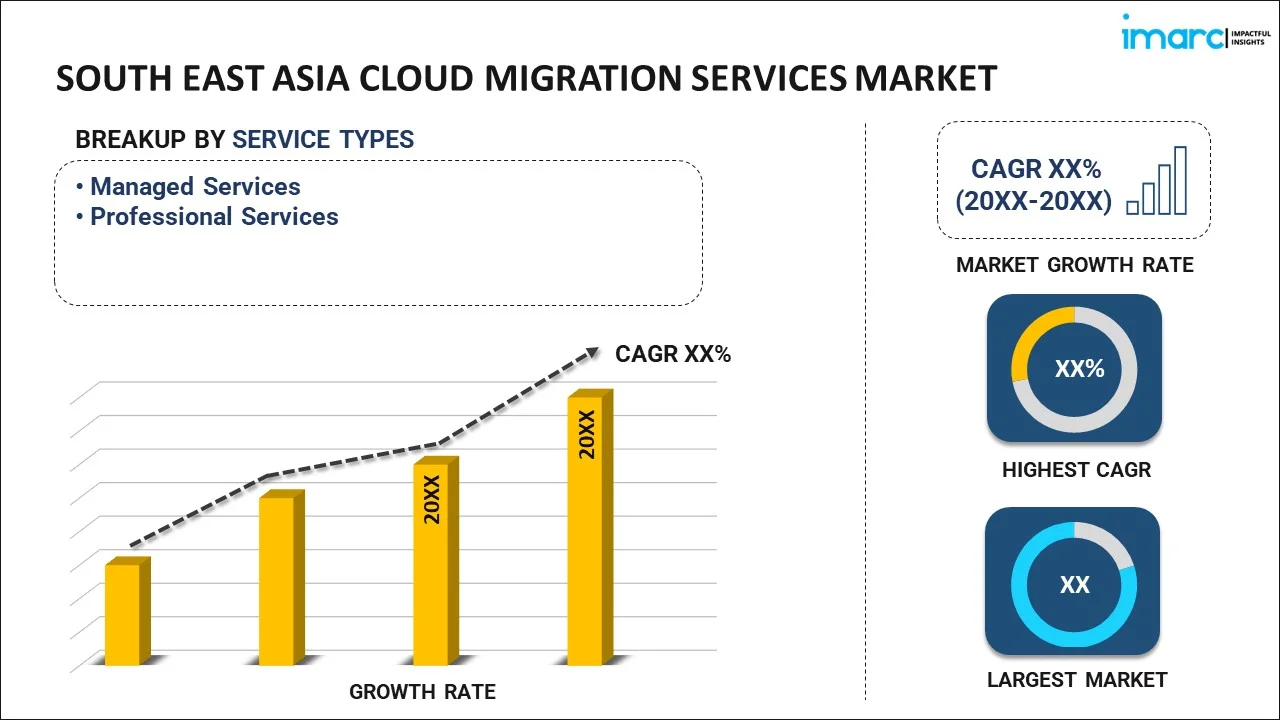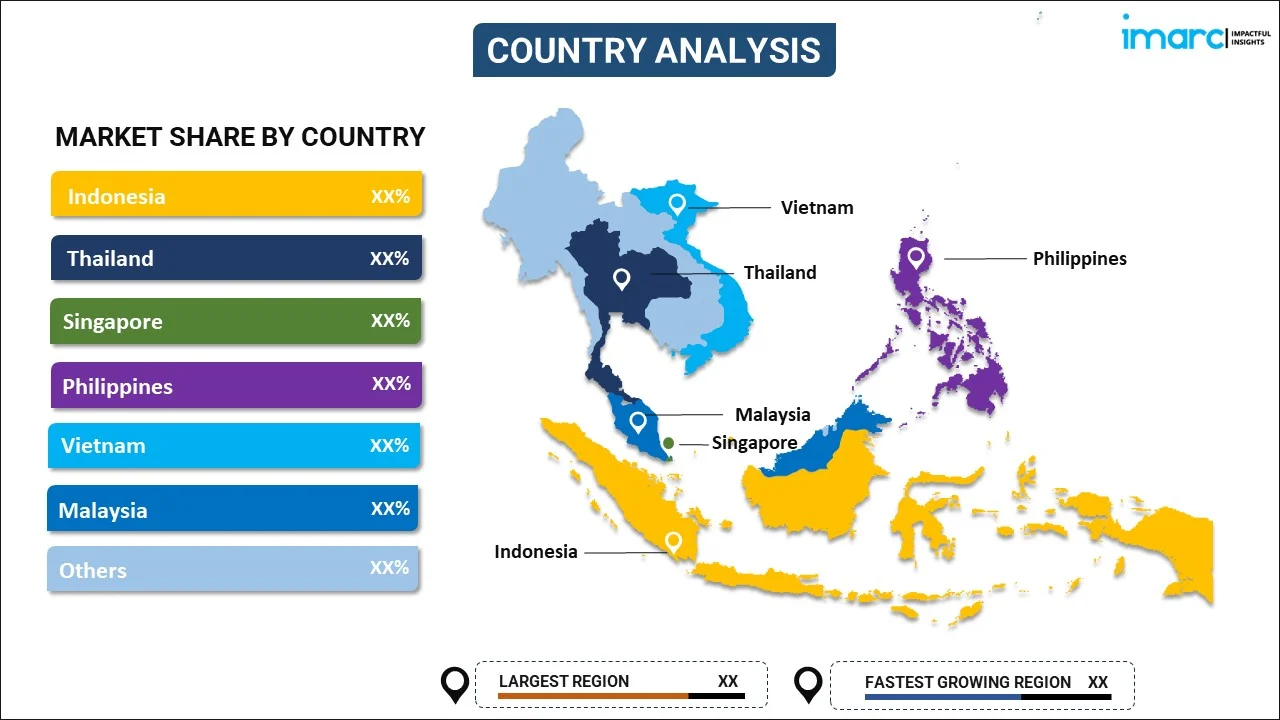
South East Asia Cloud Migration Services Market Report by Service Type (Managed Services, Professional Services), Enterprise Size (Small and Medium-sized Enterprises, Large Enterprises), Deployment Mode (Public Cloud, Private Cloud, Hybrid Cloud), Application (Project Management, Infrastructure Management, Security and Compliance Management, and Others), Industry Vertical (BFSI, Manufacturing, Healthcare and Life Sciences, IT and Telecommunications, Consumer Goods and Retail, Government and Public Sector, Media and Entertainment, and Others), and Country 2025-2033
Market Overview:
South East Asia cloud migration services market size is projected to exhibit a growth rate (CAGR) of 24.30% during 2025-2033. The growing concerns about data security and compliance, rising utilization in the telehealth services, and increasing strategic partnerships and alliances between service providers and local information technology (IT) firms represent some of the key factors driving the market.
|
Report Attribute
|
Key Statistics
|
|---|---|
|
Base Year
|
2024 |
|
Forecast Years
|
2025-2033
|
|
Historical Years
|
2019-2024
|
| Market Growth Rate (2025-2033) | 24.30% |
Cloud migration services refer to the method of transferring the digital assets of an organization, including data, applications, and workloads, ranging from on-premises infrastructure to cloud-based environments. It involves several aspects, including planning, assessment, and execution. It is manufactured through the utilization of various tools, frameworks, and methodologies designed to facilitate a smooth transition to the cloud. It is available in multiple types, rehosting, re-platforming, and refactoring, each tailored to different organizational needs. It provides organizations with improved scalability, allowing them to easily adjust resources according to need. It typically follows a pay-as-you-go model, eliminating the need for substantial upfront investments. It enhances data security and disaster recovery capabilities. It also enables businesses to host web applications, store and analyze large datasets and run complex artificial intelligence (AI) and machine learning (ML) workloads. It is instrumental in facilitating remote work by providing seamless access to applications and data from anywhere, thus increasing workforce productivity.
South East Asia Cloud Migration Services Market Trends:
At present, the increasing need for cloud migration services to modernize information technology (IT) infrastructure and migrate legacy systems to the cloud represents one of the crucial factors impelling the growth of the market in South East Asia. These services also enable businesses to harness the benefits of emerging technologies like AI, internet of things (IoT), and data analytics. Moreover, the rising focus on the cost-efficiency offered by cloud migration as it eliminates the need for extensive on-premises infrastructure and reduces operational expenses is bolstering the market growth. This is especially crucial for businesses in the region, where cost considerations play a pivotal role in decision-making. In addition, the growing concerns about data security and compliance are encouraging cloud migration service providers to offer robust security measures and compliance certifications. Apart from this, the increasing adoption of hybrid and multi-cloud strategies by businesses to achieve a balance between on-premises and cloud-based infrastructure is bolstering the market growth in the region. This approach allows businesses to optimize workloads, improve resilience, and avoid vendor lock-in. The cloud migration service providers are catering to this trend by offering solutions that seamlessly integrate various cloud platforms. Furthermore, the rising utilization of cloud-based telehealth services to enable remote consultations and facilitate access to healthcare for patients in remote areas and during emergencies is bolstering the market growth. The employment of cloud migration services in electronic health records (EHRs), enabling secure and accessible patient data from anywhere, improving patient care, and streamlining administrative processes is also positively influencing the market in the region. Besides this, the growing strategic partnerships and alliances between cloud service providers and local IT firms are enabling local businesses to access a wider range of cloud migration services and expertise, accelerating their digital transformation efforts.
South East Asia Cloud Migration Services Market Segmentation:
IMARC Group provides an analysis of the key trends in each segment of the market, along with forecasts at the regional and country levels for 2025-2033. Our report has categorized the market based on service type, enterprise size, deployment mode, application, and industry vertical.
Service Type Insights:

- Managed Services
- Professional Services
The report has provided a detailed breakup and analysis of the market based on the service type. This includes managed services and professional services.
Enterprise Size Insights:
- Small and Medium-sized Enterprises
- Large Enterprises
A detailed breakup and analysis of the market based on the enterprise size have also been provided in the report. This includes small and medium-sized enterprises and large enterprises.
Deployment Mode Insights:
- Public Cloud
- Private Cloud
- Hybrid Cloud
The report has provided a detailed breakup and analysis of the market based on the deployment mode. This includes public cloud, private cloud, and hybrid cloud.
Application Insights:
- Project Management
- Infrastructure Management
- Security and Compliance Management
- Others
A detailed breakup and analysis of the market based on the application have also been provided in the report. This includes project management, infrastructure management, security and compliance management, and others.
Industry Vertical Insights:
- BFSI
- Manufacturing
- Healthcare and Life Sciences
- IT and Telecommunications
- Consumer Goods and Retail
- Government and Public Sector
- Media and Entertainment
- Others
The report has provided a detailed breakup and analysis of the market based on the industry vertical. This includes BFSI, manufacturing, healthcare and life sciences, IT and telecommunications, consumer goods and retail, government and public sector, media and entertainment, and others.
Country Insights:

- Indonesia
- Thailand
- Singapore
- Philippines
- Vietnam
- Malaysia
- Others
The report has also provided a comprehensive analysis of all the major regional markets, which include Indonesia, Thailand, Singapore, Philippines, Vietnam, Malaysia, and Others.
Competitive Landscape:
The market research report has also provided a comprehensive analysis of the competitive landscape in the market. Competitive analysis such as market structure, key player positioning, top winning strategies, competitive dashboard, and company evaluation quadrant has been covered in the report. Also, detailed profiles of all major companies have been provided.
South East Asia Cloud Migration Services Market Report Coverage:
| Report Features | Details |
|---|---|
| Base Year of the Analysis | 2024 |
| Historical Period | 2019-2024 |
| Forecast Period | 2025-2033 |
| Units | US$ Million |
| Scope of the Report | Exploration of Historical and Forecast Trends, Industry Catalysts and Challenges, Segment-Wise Historical and Predictive Market Assessment:
|
| Service Types Covered | Managed Services, Professional Services |
| Enterprise Sizes Covered | Small and Medium-sized Enterprises, Large Enterprises |
| Deployment Modes Covered | Public Cloud, Private Cloud, Hybrid Cloud |
| Applications Covered | Project Management, Infrastructure Management, Security and Compliance Management, Others |
| Industry Verticals Covered | BFSI, Manufacturing, Healthcare and Life Sciences, IT and Telecommunications, Consumer Goods and Retail, Government and Public Sector, Media and Entertainment, Others |
| Countries Covered | Indonesia, Thailand, Singapore, Philippines, Vietnam, Malaysia, Others |
| Customization Scope | 10% Free Customization |
| Report Price and Purchase Option | Single User License: US$ 3699 Five User License: US$ 4699 Corporate License: US$ 5699 |
| Post-Sale Analyst Support | 10-12 Weeks |
| Delivery Format | PDF and Excel through Email (We can also provide the editable version of the report in PPT/Word format on special request) |
Key Questions Answered in This Report:
- How has the South East Asia cloud migration services market performed so far and how will it perform in the coming years?
- What has been the impact of COVID-19 on the South East Asia cloud migration services market?
- What is the breakup of the South East Asia cloud migration services market on the basis of service type?
- What is the breakup of the South East Asia cloud migration services market on the basis of enterprise size?
- What is the breakup of the South East Asia cloud migration services market on the basis of deployment mode?
- What is the breakup of the South East Asia cloud migration services market on the basis of application?
- What is the breakup of the South East Asia cloud migration services market on the basis of industry vertical?
- What are the various stages in the value chain of the South East Asia cloud migration services market?
- What are the key driving factors and challenges in the South East Asia cloud migration services?
- What is the structure of the South East Asia cloud migration services market and who are the key players?
- What is the degree of competition in the South East Asia cloud migration services market?
Key Benefits for Stakeholders:
- IMARC’s industry report offers a comprehensive quantitative analysis of various market segments, historical and current market trends, market forecasts, and dynamics of the South East Asia cloud migration services market from 2019-2033.
- The research report provides the latest information on the market drivers, challenges, and opportunities in the South East Asia cloud migration services market.
- Porter's five forces analysis assist stakeholders in assessing the impact of new entrants, competitive rivalry, supplier power, buyer power, and the threat of substitution. It helps stakeholders to analyze the level of competition within the South East Asia cloud migration services industry and its attractiveness.
- Competitive landscape allows stakeholders to understand their competitive environment and provides an insight into the current positions of key players in the market.
Need more help?
- Speak to our experienced analysts for insights on the current market scenarios.
- Include additional segments and countries to customize the report as per your requirement.
- Gain an unparalleled competitive advantage in your domain by understanding how to utilize the report and positively impacting your operations and revenue.
- For further assistance, please connect with our analysts.
 Inquire Before Buying
Inquire Before Buying
 Speak to an Analyst
Speak to an Analyst
 Request Brochure
Request Brochure
 Request Customization
Request Customization




.webp)




.webp)












